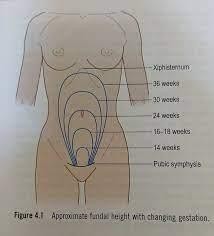A nurse is assisting in obtaining the fundal height measurement for a client who is at 32 weeks of gestation. Which of the following images indicates where the nurse should expect the client's fundus to be located?

The fundal height corresponds with approximately 16 weeks.
The fundal height corresponds with approximately 20 weeks.
The fundal height corresponds with approximately 32 weeks.
The fundal height corresponds with approximately 24 weeks.
The Correct Answer is C
A) Incorrect- the fundal height corresponds with approximately 16 weeks. At around 16 weeks of gestation, the fundal height is usually located approximately at the midpoint between the symphysis pubis (pubic bone) and the belly button (umbilicus). This measurement corresponds to the anatomical level of the uterus at this stage.
B) Incorrect- the fundal height corresponds with approximately 20 weeks. By 20 weeks of gestation, the fundus has typically reached the level of the umbilicus. The fundal height measurement is around the same level as the belly button.
C) Correct- the fundal height corresponds with approximately 32 weeks. Around 32 weeks of gestation, the fundal height has increased significantly compared to earlier stages of pregnancy. The fundus of the uterus is located above the belly button, and the measurement is typically about 32 centimeters (or roughly 12.6 inches) above the symphysis pubis.
D) Incorrect- the fundal height corresponds with approximately 24 weeks. Around 24 weeks of gestation, the fundal height is usually about 1 to 2 fingerbreadths above the
umbilicus. This represents the ongoing upward growth of the uterus as the pregnancy progresses.
E) Incorrect- the fundal height corresponds with approximately 18 weeks. At around 18 weeks of pregnancy, the fundal height is typically located just above the pubic bone, below the belly button (umbilicus). The fundus of the uterus is still relatively low in the abdomen at this point. The fundal height measurement at 18 weeks is usually around the midpoint between the symphysis pubis (pubic bone) and the belly button.
Nursing Test Bank
Naxlex Comprehensive Predictor Exams
Related Questions
Correct Answer is C
Explanation
A) Incorrect- Cleansing the perineum with povidone-iodine is not relevant to the collection process.
B) Incorrect- The 24-hour collection should start with the first-morning urination, not with any random urination.
C) Correct - Recording the time on the collection container for any missed urine specimens is important for accurate measurement.
D) Incorrect- Stool should not be added to the urine collection container, but this is not the most important point to emphasize in this teaching.
Correct Answer is B
Explanation
A) Incorrect- Scheduling a routine 1-month appointment is not appropriate given the elevated glucose value. A 1-hour glucose screening test value of 130 mg/dL indicates an elevated glucose level, which suggests the need for further testing to confirm or rule out gestational diabetes.
B) Correct - An elevated glucose value on the initial screening test requires confirmation through a more comprehensive test, such as the 3-hour oral glucose tolerance test.
C) Incorrect- Home glucose monitoring might be indicated for gestational diabetes but is not the next step after an elevated 1-hour glucose screening test.
D) Incorrect- Repeating the 1-hour glucose test in 1 week is not necessary; if the initial test is elevated, further testing is required.
Whether you are a student looking to ace your exams or a practicing nurse seeking to enhance your expertise , our nursing education contents will empower you with the confidence and competence to make a difference in the lives of patients and become a respected leader in the healthcare field.
Visit Naxlex, invest in your future and unlock endless possibilities with our unparalleled nursing education contents today
Report Wrong Answer on the Current Question
Do you disagree with the answer? If yes, what is your expected answer? Explain.
Kindly be descriptive with the issue you are facing.
